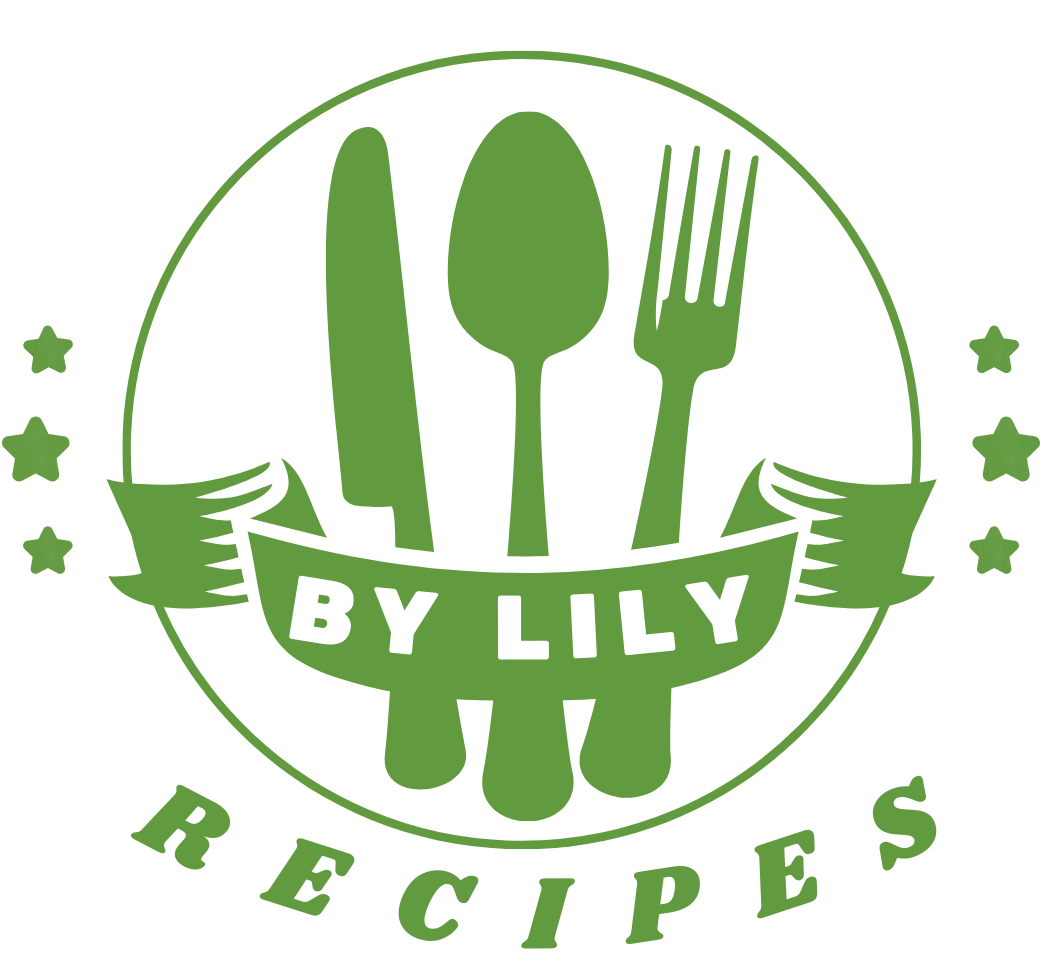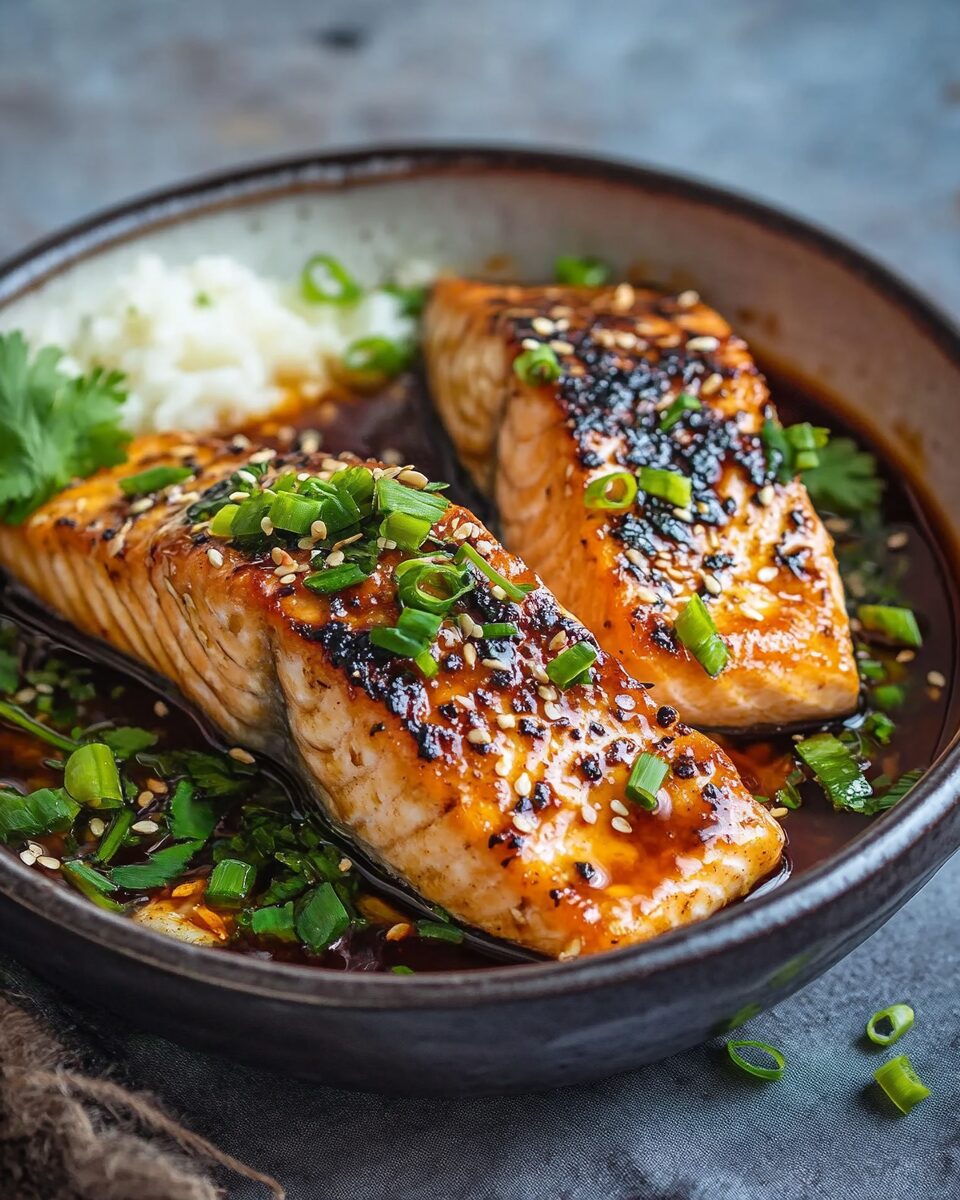This Hibachi Salmon is a Japanese steakhouse-style dish that you can easily prepare at home in under 20 minutes. With perfectly seared salmon fillets coated in a flavorful soy-based sauce, this dish pairs wonderfully with hibachi fried rice, noodles, or a side of vegetables. It’s a quick, delicious, and budget-friendly way to enjoy restaurant-quality hibachi salmon at home!
Full Recipe:
Ingredients
- 2-3 salmon fillets (5-6 oz each, skin on or off)
- 1 tablespoon toasted sesame oil
- 1 tablespoon extra virgin olive oil
- 1 tablespoon minced garlic
- 1 tablespoon minced ginger
- 2 tablespoons soy sauce (or tamari for gluten-free)
- 2 tablespoons cooking wine (or rice vinegar or white wine vinegar)
- 2 tablespoons freshly squeezed lemon juice (or 1 tablespoon lime juice)
- ¼ teaspoon freshly ground black pepper
Directions
- Prepare the salmon by rinsing the fillets and patting them dry with paper towels to remove excess moisture. This prevents steaming and ensures a nice sear.
- Heat a non-stick pan over medium-high heat. Add sesame oil and olive oil.
- Sear the salmon by placing the fillets in a single layer and cooking for about 4 minutes. Flip gently and cook the other side for another 3-4 minutes. The salmon should still be slightly pink in the center, as it will continue to cook once removed from heat.
- Transfer the salmon to a plate and set aside. Reduce the heat to medium.
- Prepare the sauce by adding minced garlic and ginger to the same pan. Sauté for 15-20 seconds.
- Add the remaining ingredients (soy sauce, cooking wine, lemon juice, and black pepper). Stir continuously and cook for about 10-15 seconds.
- Coat the salmon by placing the fillets back into the pan and spooning the sauce over them.
- Serve hot with hibachi fried rice, vegetables, or noodles, and drizzle any remaining sauce over the salmon.
Nutrients (Per Serving – Approximate)
- Calories: 388
- Protein: 36g
- Carbohydrates: 3g
- Fat: 25g
- Saturated Fat: 4g
- Cholesterol: 94mg
- Sodium: 1082mg
- Potassium: 910mg
- Fiber: 0.4g
- Sugar: 1g
- Vitamin A: 72IU
- Vitamin C: 7mg
- Calcium: 32mg
- Iron: 2mg
Enjoy your homemade Hibachi Salmon with your favorite sides for a delicious and satisfying Japanese-inspired meal! 🍣
What is Hibachi-Style Cooking?
Hibachi cooking originates from Japan and refers to grilling food over a high-heat, open-flame grill. In many Western hibachi-style restaurants, chefs cook on a flat iron griddle, known as a teppan, which allows for high-heat searing and rapid cooking. The method is famous for its ability to create a smoky, charred flavor while locking in the natural juices of the food.
Unlike traditional hibachi steak or chicken, which are grilled at high temperatures, hibachi salmon is pan-seared in a hot skillet with sesame oil and a flavorful sauce. This cooking technique ensures a perfectly crispy outer layer while keeping the inside tender and flaky.
Why Hibachi Salmon is a Must-Try Dish
Hibachi Salmon stands out as a dish that balances flavor, nutrition, and ease of preparation. The seared salmon is infused with the umami-rich flavors of soy sauce, garlic, and ginger, while the splash of lemon juice adds a bright, citrusy contrast. The simplicity of the ingredients ensures that the natural taste of the salmon shines through, making it a wholesome and delicious meal.
This dish is also highly versatile. It pairs beautifully with classic hibachi sides like fried rice, sautéed vegetables, or noodles. Whether you’re cooking for a busy weeknight dinner or looking to impress guests with a gourmet-style meal, Hibachi Salmon is a perfect choice.
The Secret to Perfectly Seared Salmon
Achieving a restaurant-style sear on salmon requires a few key techniques. First, ensuring that the salmon is dry before searing is essential. Excess moisture can prevent the fish from developing a crispy crust. Pat the fillets dry with a paper towel before cooking.
Second, using a combination of sesame oil and olive oil allows for high-heat cooking while adding a hint of nutty flavor. A well-heated pan is crucial—placing salmon in a cold or lukewarm pan will result in a lackluster sear.
Finally, avoid overcooking. Salmon continues to cook even after it is removed from heat, so it’s best to pull it off the stove when it is slightly translucent in the center. This ensures a perfectly flaky texture without drying out the fish.
Enhancing the Flavor with a Delicious Sauce
The sauce is what truly elevates this dish. A blend of soy sauce, garlic, ginger, lemon juice, and a hint of cooking wine creates a well-balanced, savory-sweet flavor profile. The sauce is cooked briefly to enhance its depth, then spooned over the salmon fillets to coat them in a rich glaze.
For those who enjoy a bit of heat, adding a pinch of red pepper flakes or a drizzle of sriracha can give the dish a spicy kick. If you prefer a sweeter taste, a teaspoon of honey or brown sugar can mellow out the acidity of the lemon juice and enhance the umami flavor.
Perfect Pairings for Hibachi Salmon
Hibachi Salmon pairs well with a variety of sides, making it an incredibly versatile dish. Some of the best accompaniments include:
Hibachi Fried Rice: This classic side dish is made with rice, scrambled eggs, soy sauce, and sautéed vegetables. It absorbs the flavors of the hibachi sauce, making it a great complement to the salmon.
Hibachi Vegetables: A mix of zucchini, mushrooms, onions, and carrots cooked in a light soy sauce blend adds both nutrition and a fresh contrast to the rich salmon.
Hibachi Noodles: Stir-fried noodles tossed with butter, soy sauce, and garlic provide a satisfying and flavorful side that pairs wonderfully with the salmon’s umami-rich sauce.
For a lighter option, you can serve Hibachi Salmon with a simple side salad or steamed jasmine rice to let the bold flavors of the fish take center stage.
Health Benefits of Hibachi Salmon
Not only is this dish delicious, but it also comes with a host of health benefits. Salmon is an excellent source of high-quality protein, essential for muscle repair and overall body function. It is also rich in omega-3 fatty acids, which promote heart health, reduce inflammation, and support brain function.
Additionally, salmon contains important vitamins and minerals, including vitamin D, B12, and selenium. These nutrients contribute to strong bones, improved immune function, and better metabolism regulation. When paired with fresh vegetables and whole grains, Hibachi Salmon makes for a well-rounded, nutritious meal.
Variations and Customizations
One of the great things about Hibachi Salmon is how easily it can be customized to suit different preferences. Here are a few ways to switch up the recipe:
- Gluten-Free Version: Use tamari instead of soy sauce to make this dish gluten-free.
- Low-Sodium Option: Opt for low-sodium soy sauce and adjust the seasoning to taste.
- Spicy Kick: Add chili paste, red pepper flakes, or a splash of sriracha to intensify the heat.
- Sweet & Savory: Mix in a small amount of honey or maple syrup for a subtle sweetness that balances the soy sauce and lemon juice.
Tips for Storing and Reheating
If you have leftovers, Hibachi Salmon can be stored in an airtight container in the refrigerator for up to three days. To maintain its texture and flavor, reheat it gently over low heat in a pan, adding a splash of water or extra sauce to keep it moist. Avoid microwaving, as this can cause the fish to dry out and lose its flaky consistency.
For meal prep, you can cook the salmon ahead of time and store it separately from the sauce. When ready to eat, simply reheat the salmon and drizzle the sauce over it for a fresh, just-cooked taste.
Conclusion
Hibachi Salmon is the perfect way to bring the flavors of a Japanese steakhouse into your own kitchen. With its crispy, golden sear, rich umami glaze, and quick cooking time, this dish is a fantastic choice for a weeknight dinner or special occasion meal. Its versatility allows for numerous variations, and its health benefits make it a nutritious option for those looking to enjoy a well-balanced, protein-rich meal.
By mastering a few key techniques and using simple, fresh ingredients, you can create a delicious and restaurant-quality hibachi salmon dish at home. Whether paired with fried rice, hibachi noodles, or sautéed vegetables, this recipe is sure to become a favorite in your household.






